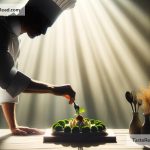How to Use Shadows Creatively in Food Photography
When you think about food photography, the first image that might pop into your head is a brightly lit dish, bursting with colors, and ready to jump off the plate. But have you ever considered the role of shadows in making food photos more dramatic and enticing? Shadows, often overlooked, are powerful tools that can add depth, contrast, and a sense of mystery to your images. Today, let’s delve into how you can use shadows creatively in food photography.
Understanding Shadows
Before we jump into techniques, it’s essential to grasp what shadows can do for your photos. Shadows are not just the absence of light; they are a visual representation of texture, shape, and dimension. They can help define the contours of a dish, create a mood, or even direct the viewer’s eye towards the main subject of your photo.
1. Play with the Light Source
The first step in mastering shadows is to experiment with your light source. Whether you’re using natural sunlight or an artificial light setup, the angle and distance of the light from your food will significantly affect how shadows appear.
-
Natural Light: If you’re shooting with natural light, try positioning your setup near a window. The time of day will dramatically influence the length and intensity of the shadows, with early morning or late afternoon light creating longer, softer shadows. Midday light, on the other hand, offers shorter, sharper shadows.
-
Artificial Light: When using artificial lights, you have more control over the direction and softness of the shadows. Moving the light closer to the subject will create softer shadows, while moving it away results in sharper, more defined shadows. Experiment with different angles to see how they change the scene.
2. Modify the Shadows
Once you have your light set up, it’s time to play around with modifying the shadows. You can use various tools to either soften or exaggerate the shadows in your scene.
-
Diffusers: Soften harsh shadows by placing a diffuser between the light source and the food. This could be a professional photography diffuser or something as simple as a piece of white fabric. It scatters the light, creating softer, more even shadows.
-
Reflectors: If you want to fill in some of the darker areas without eliminating the shadows entirely, use a reflector. This can be a professional reflector, a piece of white cardboard, or even a foil-covered board for stronger reflection. Position it on the opposite side of the light source to bounce some light back onto the subject.
-
Gobos: To create more dramatic and defined shadows, you can use gobos (go-betweens), which are objects placed between the light source and the subject to cast interesting shadows. This can be anything from a lace curtain to a piece of cut-out cardboard, allowing you to get creative with the shapes and patterns of your shadows.
3. Composition and Background
The composition of your photo and the choice of background can also influence how shadows contribute to the overall effect.
-
Playing with Angles: Experiment with different shooting angles to see how they affect the length and direction of the shadows. Sometimes, a slightly elevated or side angle can make the shadows more appealing and add depth to your photo.
-
Choosing the Right Background: Consider how the shadows will look against the background you choose. A darker background can make light shadows stand out, while a lighter background can highlight darker shadows. The texture of the background can also interact interestingly with the shadows, adding another layer of depth.
Closing Thoughts
Shadows, often seen as a challenge to be overcome, can actually be one of your greatest assets in food photography. They add mood, contrast, and interest, turning a flat image into a story. The key is to experiment and see shadows as a creative tool rather than a hurdle. By adjusting your light source, modifying shadows with simple tools, and considering your composition carefully, you can take your food photography to new, dramatic heights. Remember, like any art form, it’s all about playing around and finding what works best for you. Happy shooting!


